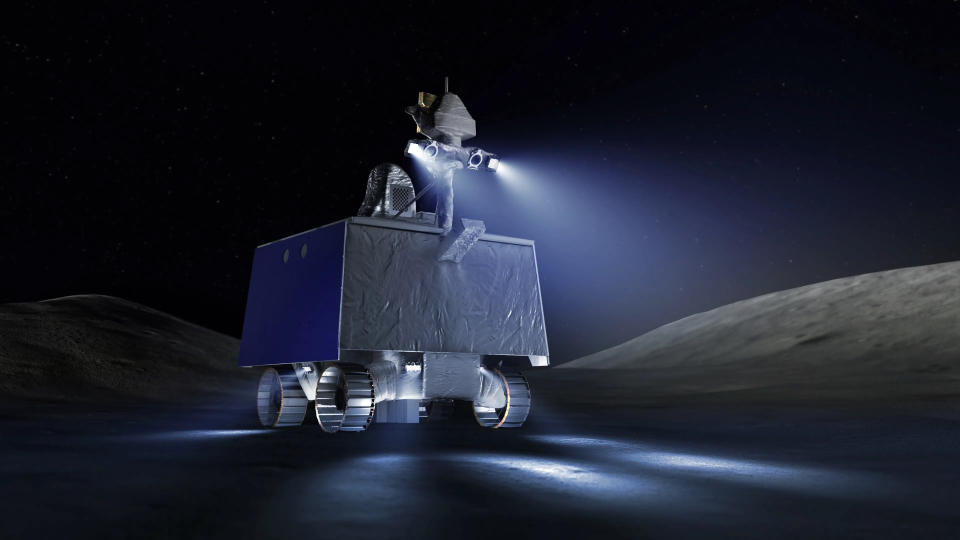NASA cancels $450 million VIPER moon rover due to budget concerns
When you buy through links on our articles, Future and its syndication partners may earn a commission.

NASA has cancelled its VIPER moon rover program due to rising costs.
VIPER, short for Volatiles Investigating Polar Exploration Rover, was a robotic mission intended to land near the moon's south pole and spend 100 days scouting for lunar ice deposits. The rover was slated to launch in 2025 to the moon aboard an Astrobotic Griffin lander as part of NASA's Commercial Lunar Payload Services initiative (CLPS). Now, it appears VIPER will be scrapped for parts or potentially sold to industry.
The decision to axe the VIPER mission was announced today (July 17) in a teleconference; cancelling the program is expected to save the agency an additional $84 million in development costs. NASA has spent about $450 million on the program so far, not including launch costs.
Despite the cancellation, NASA leadership stressed that the program was successful thus far and that the termination was solely a budgetary concern.
"We were very confident in the VIPER team. This really gets down to cost and a very constrained budget environment in the United States," said Joel Kearns, deputy associate administrator for exploration at NASA headquarters in Washington, during today's teleconference.
"First and most important, this is in no way a reflection on the quality of the work from the mission team that are working to build this rover," said Nicola Fox, associate administrator of NASA's Science Mission Directorate. "They have worked diligently, including through the pandemic, to be able to build this rover to look for water on the moon.
"This is a very tough decision, but it is a decision based on budgetary concerns in a very constrained budget environment," Fox added at the end of the teleconference.

At the time of its cancellation, the car-sized VIPER was completely assembled and undergoing environmental testing to ensure the rover could handle the physical stresses of launch and the harsh environment of space.
NASA is now looking to "potentially de-integrate and reuse VIPER scientific instruments and components for future moon missions" Kearns said today, but will first ask both U.S. and international industry partners for any interest in using the rover as-is.

Despite the VIPER program's end, NASA is confident that its same science objectives can be accomplished through future lunar exploration initiatives.
NASA's upcoming Lunar Terrain Vehicle, for example, which is designed to carry astronauts on the moon, is designed to also be operated remotely so that it might be able to explore permanently shadowed regions near the lunar south pole in search of ice.
Other lunar landers might also be able to send instruments similar to those planned for VIPER to the same areas. "We're looking at the possibility for being able to send CLPS landers either into permanently shadowed regions, or to have CLPS landers provide some type of mobility that would get the instruments in the permanently shadowed regions," Kearns said during today's teleconference.
"So we believe that, over time, we are going to be able to address the science objectives that we originally identified specifically for VIPER."
RELATED STORIES:
— NASA unveils landing site on the moon for ice-hunting VIPER rover
— Private Peregrine moon lander failure won't stop NASA's ambitious commercial lunar program
— NASA picks 9 companies to develop Mars 'commercial services' ideas
NASA's fiscal year 2025 budget has forced agency leadership to make difficult decisions about many other ambitious science programs. Funding for the agency's science programs as a whole was reduced by $1 billion for 2025, Fox said today. That reduction is forcing NASA's Science Mission Directorate to "have to make some pretty tough choices," Fox said during a separate teleconference concerning the agency's budget in March.
Other programs facing tough choices could have far-reaching impacts on NASA's science and astronomy missions. The Chandra X-ray telescope is facing a dark future (literally) as its budget has been axed significantly, falling from $41.1 million in 2025 to only $5.2 million in 2029. The ambitious Mars Sample Return program is also now seeking alternative concepts of operation after its price tag ballooned to over $11 billion, drawing Congressional ire.
